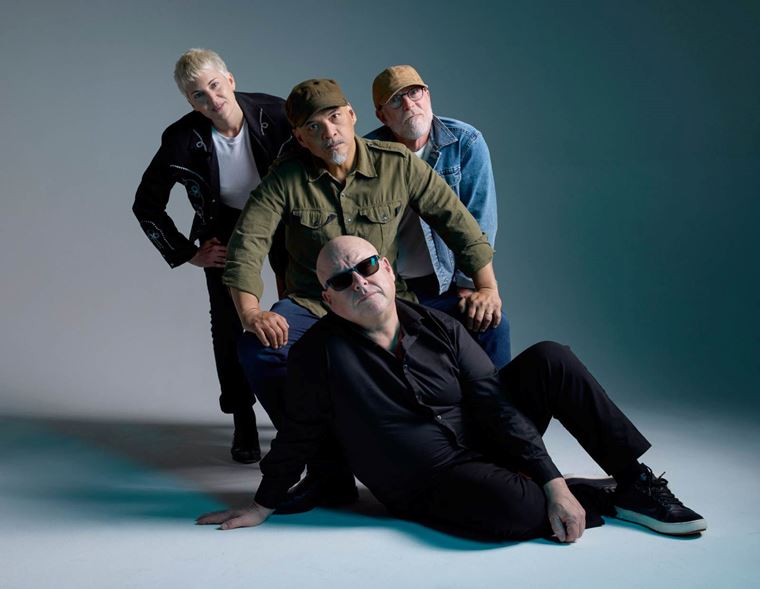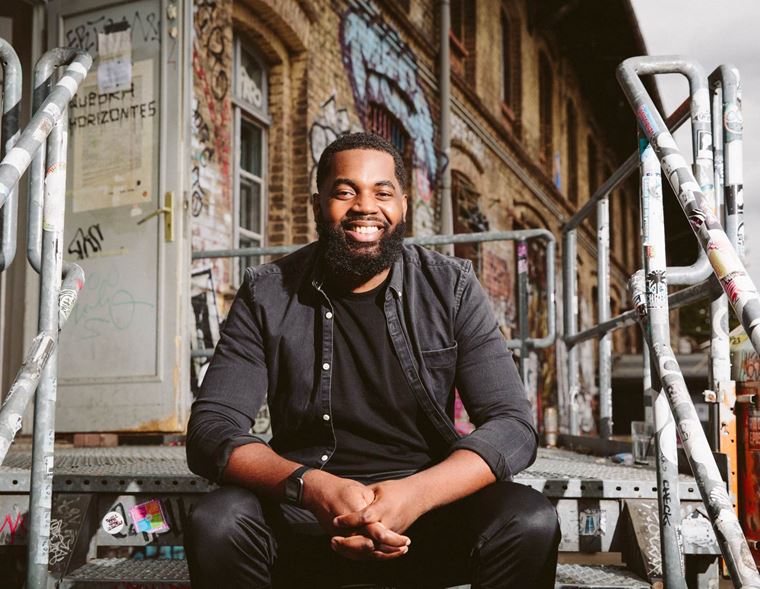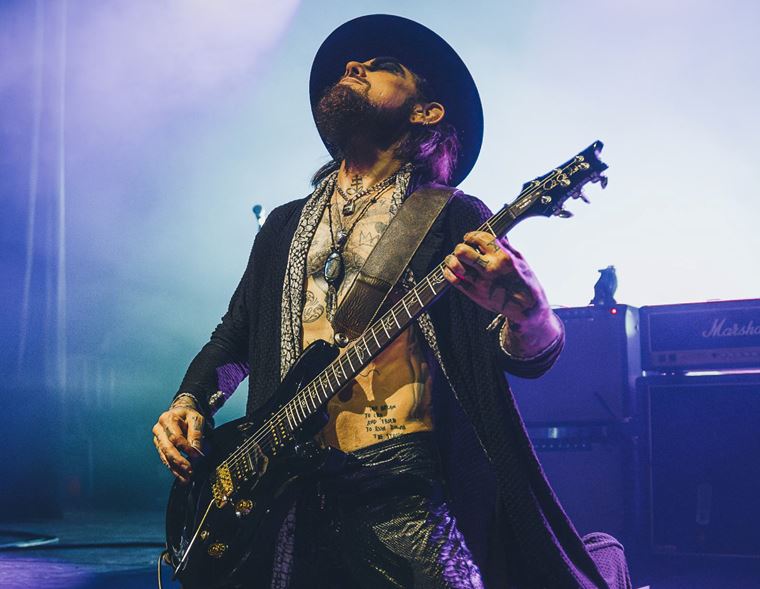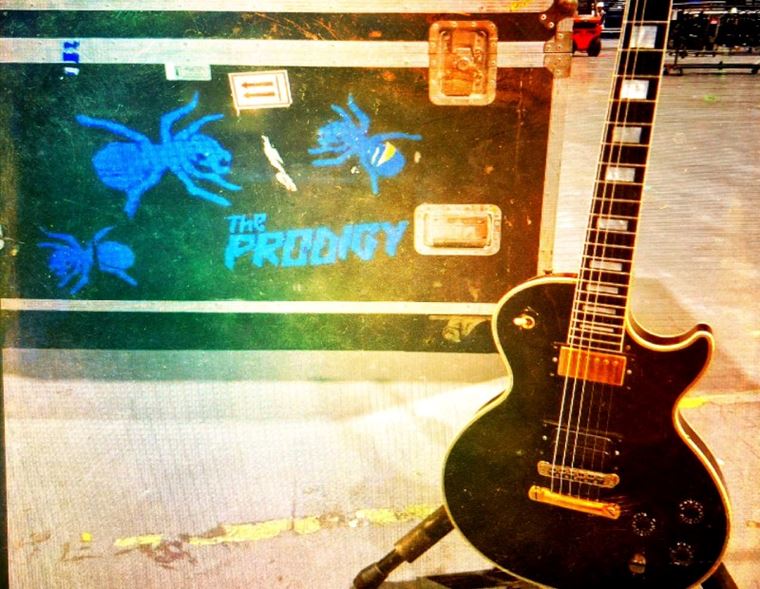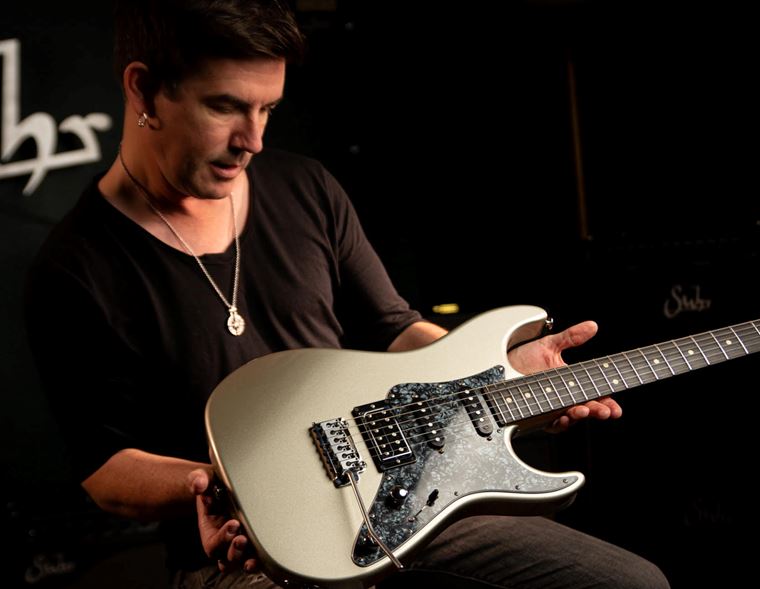The guitarguitar Interview: Slipknot's Jim Root
Published on 31 January 2020
Outside of perhaps Metallica, Slipknot must be the biggest metal band on the planet, right now. Their brutal, nihilistic sound is by no means mainstream, but by tempering the sledgehammer dynamics with an undeniable knack for catchy hooks, Slipknot have managed to create a sound and an aesthetic that has enthralled huge numbers of music fans for two decades.
And what an aesthetic!
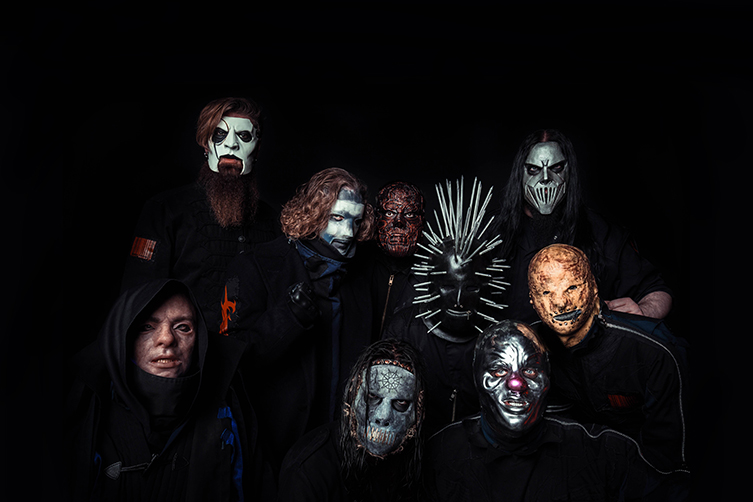
(Photo: Alexandria Crahan-Conway)
9 intimidating men in matching boiler suits and horror-movie masks; guitars, drums, percussion, samples, scratching, more percussion and distinctive vocals, all tripping over themselves in a devastating onslaught of dynamics, rage and catharsis. Over six studio albums and two live albums, Slipknot’s raw and honest documenting of hardship and mental fragility have resounded with huge effectiveness, resulting in a massive worldwide fanbase. Indeed, Corey Taylor, Jim Root and Mick Thomson are all household names amongst fans of heavy music. Everyone has their favourite mask!
Critics may have complained about the ‘constructed’ nature of the band’s image to begin with, but those criticisms were quickly silenced. Slipknot, the band have proven time and again, are the real deal. Their image is attention-grabbing rather than attention-seeking; the issues they sing about – mental health, relationships, real-life struggles – have hit a chord with multiple generations of music fans, and their incendiary performances have blended theatre and intensity in ways that reference bands like Kiss, Rob Zombie and Rammstein but take the chaos further. You only need a cursory listen or watch to realise that there is something very 'real' going on.
If Slipknot are in town, and you like a good show, there really is only one place to be...
Recently, Slipknot were indeed in town.
Last August, the band released We Are Not Your Kind, their sixth studio album and their first in five years. The years have not diluted the venom and volatility available to the band, nor has it blunted their attack: this is ferocious stuff, bringing the kind of sound that only two monster guitarists, three percussionists, an intensely brilliant vocalist and a whole team of other miscreants can! Compromise, it seems, is not a word in their collective lexicon.
For this tour, Slipknot have brought the equally uncompromising and equally ferocious Behemoth with them. In a turn of extreme fortitude, I found myself lucky enough to be scheduled to speak to both. Behemoth’s story will be told separately: here, we will focus on the Slipknot experience.
Slipknot’s security is intense. I’m met outside the SSE Hydro by Slipknot Management Representative Kristina, who chats to me happily as we make our way into the backstage warren. Every corner of every corridor has a staff member with a walkie-talkie waiting to appraise whomever approaches. I have no pass, which is noticed by a large, unsmiling security officer with a headset. I’ve been here to talk to bands before, but this is next level! I stop to consider it all before thinking that this is maybe how it should always be done.

Kristina shows me into a dressing room and asks me to wait for a minute or two. She is juggling a million jobs but does it all in a calm, friendly way. I wouldn’t say I’m nervous as such, but there is always the pre-interview apprehension that courses through one’s body. What will Jim be like in person? Is he interested in talking? Will this be easy or difficult? The members of Slipknot are all fairly private people, so outside of his playing, I really don’t know too much about him. Plus, he plays in one of the biggest metal bands ever...
I needn’t have worried. Kristina re-enters the room with Jim, who positively towers above me and extends his hand in greeting. Jim has tons of hair and an impressive beard, both of which he fiddles with as we talk. He’s really good company: easy to talk to, happy to chat and listen, very ‘even’ with his energy. He likes to laugh. For one of the biggest and most influential guitarists in modern metal, Jim Root is a pretty humble guy, really: there is no pretension about him at all. Throughout our conversation, he is frequently self-deprecating: it's worth noting as you read this that his overall tone is quite jocular, despite some of the weightier subjects he may allude to.
He’s also more than ready to chat about guitars, which is what we’re there for! Without further preamble, this is how our interview went:
guitarguitar: So, this is for guitarguitar.
Jim Root: Right on.
GG: So it’s just gonna be guitar chat, basically!
JR: Cool!
GG: Sweet! So, am I right in saying it’s a few nights into the tour?
JR: Yeah, I couldn’t even begin to tell ya, I’m so spun out lately! (laughs) I think this is gonna be show number four? Three or four? Something like that?
GG: Sounds about right. And how has the new material been going down with the audiences?
JR: It’s been going down really well! It’s weird, you can kinda see a sort of a ...there’s not a real big overlap of our new fans with our old fans. We’ve been playing stuff off the first record, and you can tell those who’ve been with us since 2000 or whenever.
GG: Mm-hmm.
JR: And then we play the new songs and you can see the people who’ve just started listening to us, you know, in the past few years, so I think you see a little bit of that. Y’know, I thought there’d be a little bit more of an overlap, but they’re all into it! Like kinda equally but not really? Yeah, it’s kinda bizarre.
GG: Yeah, totally.
JR: Plus, the flow of the set we’re playing right now, I haven’t really been able to catch a vibe with it.
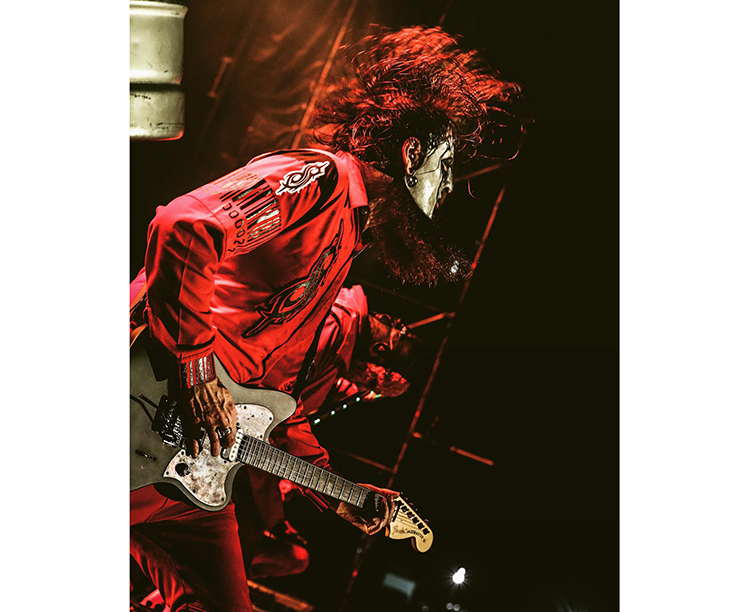
(Photo: Anthony Scanga)
GG: Okay.
JR: Yeah, there’s a couple of songs that I don’t think we should be playing. Like, I’m not much of a fan of playing Eeyore live, and we’re doing Eeyore, you know? I think that’s more of a sort of straight forward, in-your-face, punk rock kinda fuckin’ tune, you know?
GG: Yeah.
JR: Blast-beat-ey, whatever. That kinda tune. We replaced Get This with Eeyore, and I think Get This is a better live tune because it’s got like the breakdown with the chant, you know?
GG: Totally!
JR: Just shit like that. I’m just starting to get into that. I takes me a couple of weeks to get into the zone when I haven’t been playing for a while, you know, especially when we change the setup.
GG: So, you do change it? It’s not like it’s gonna be the same set for you every night of the tour?
JR: Um, no, it’s gonna be...I mean, we may change a couple of songs here and there throughout the run but, I mean, it’s so early on and most of us, like...I didn’t go to bed until 7 in the morning last night (laughs), like, I’ve literally been awake for an hour until now! (note: it’s around 4.30pm – Ray)
GG: Wow! I doubly appreciate you taking time to talk, haha!
JR: Yeah, we, you know, it’s hard to go to sleep after, you know, you get off stage after eleven o’clock at night and it’s like, do 90 minutes of cardio...
GG: Yeah, yeah, yeah!
JR: And I don’t eat much throughout the day, plus the jetlag and all that, you know what I mean?
GG; Yeah, it’s a bit of a shock to the system!
JR: Yeah, and I’m an old motherfucker as well! (laughs) Added to the situation! I’m like ‘what the fuck am I doing with my life’! Haha!
GG: I dunno, I think you did alright, man!
JR: Hahaha!
GG: So, with that kind of situation, it’s interesting to hear how you’re not particularly up for this particular song, you’d rather play that song...
JR: Yep.
GG: Because there are so many people in Slipknot, is it one of those ones where there’s a democratic decision on those things? 'If 6 people want it, it happens', kind of thing?
JR: Yeah, I mean the setlist came about like, you know, Corey texted me while we were on break and he was like ‘what do you think about this?’ for a setlist and I just kinda skimmed through it and was like ‘holy shit, yeah! That looks like a rager!’ You know? He was like, ‘Cool, I’ll send it off to Clown (Shawn Crahan, Slipknot percussionist), get his okay. Then I see a mass email go out with ‘this is the set’, then we’ll do like a group chat or whatever with the band. People will throw their ideas out, you know?
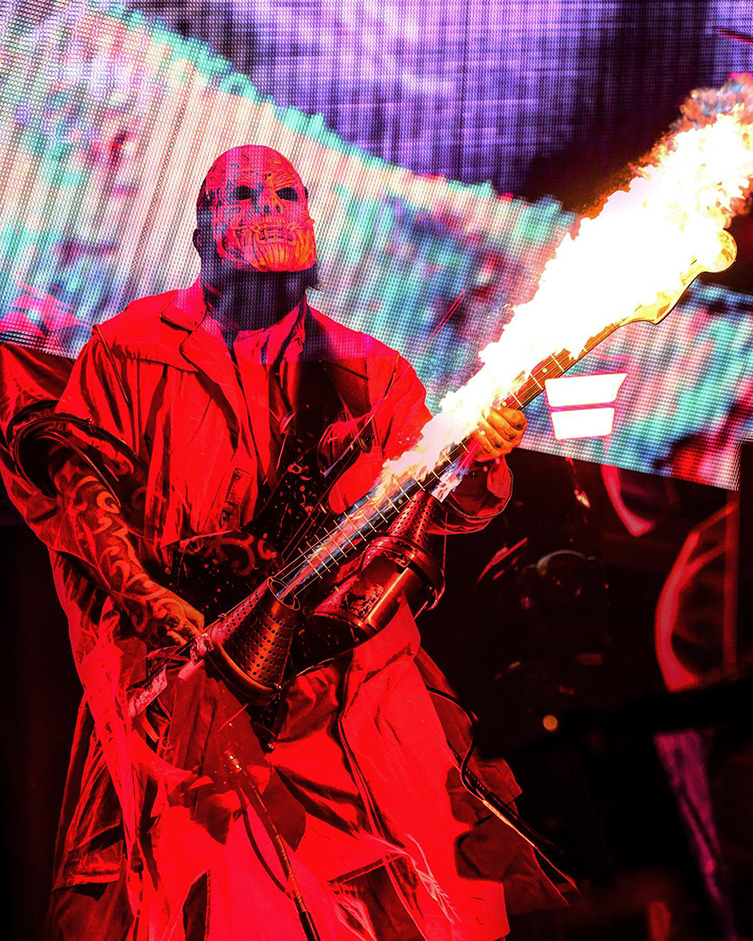
(Photo: Anthony Scanga)
GG: Sure.
JR: I’ll make a playlist of the set list, like on Spotify or whatever and if I have, you know, the gumption to do it, I’ll sit there and I’ll practice through it. But yeah, then we get on the road and play it, see how it feels, see if there’s anything that needs tweaking. It takes a few shows to get into the zone of it. Even how long we’re gonna stay backstage between songs, and transitions between songs. You know, the pyro guy’s gotta line up with the video guys and the lighting guys and all that.
GG: Production gets involved, yeah.
JR: Yeah! It’s hard and when we rehearse a set, we have to rehearse the whole set for the video guys and all that. There might be new songs included that Clown designed a video for and stuff like that, so.
GG: Presumably as well, you’ll have different instruments for different songs, so it’s like ‘can I do these three songs with that same tuning or do I have to keep changing guitars’?
JR: Yeah! And that’s one of those things you notice with our history. In the middle of the set, we’ll always have 3 songs stuff together that are in A tuning, and the rest of ‘em will be in our B tuning.
GG: Ah okay! To minimise changes?
JR: Yeah. ‘Hey Corey, if you’re gonna do a set list, don’t...if you wanna have three in a row, don’t have an A song in between two B songs, cuz we’re gonna have to do a guitar switch.’
GG: Precious minutes count!
JR: Yeah, sure.
GG: So, in terms of guitars, when you’re on stage, would you prefer to be playing on the same actual instrument for a good few songs?
JR: Sometimes, yeah, but my guitars...I mean, I’m lucky because my signature models are all pretty consistent, so they don’t really differ that much from each other. What really flips me out is, like, I’ve been favouring my Jazzmasters for the past few years a lot more because they’re so well balanced. They’re a little bigger a guitar and I’m fucking 6 foot 6 (laughs) so it looks more natural on me, you know what I mean? Haha!
But when I go from a Jazzmaster to, say, a Strat, it just...you know, the Jazzmaster neck is over this way (mimes off to the left-hand side), much farther, so it feels like you’re playing a baritone after you’ve been playing a Tele or a Strat.
GG: Totally!
JR: But it’s not, it’s just how it sits on your body. So that’s the only kinda weird thing. And I haven’t really been playing my Teles all that much, hardly at all. I don’t even think I have a Tele with me on this tour!

GG: Okay! That was your first signature one of course, back...that would have been about 12 years at least, right?
JR: Yeah, and my main White one, my very first one, the one I use on all the records and stuff, I left it at home. I talked about retiring it from touring quite a while ago just because so many producers liked it in the studio. Like, if anything happens to it – if it gets stolen or if it gets broken or smashed up or whatever, and it’s already pretty beat up, relic’d, you know? And it looks pretty cool right now...
GG: Keep it that way!
JR: That’s why I kept it, but I want it, like, relic’d more! (laughs) The more I play it, the more it just gets worn in. More paint starts wearing off of it...
GG: Man, you should talk to the Fender Custom Shop about doing one of them for release!
JR: Yeah, maybe one of these days they would, you know? Make me a copy of it. Give it to the custom luthiers and let them do an exact copy of it. Leave the original one at home.
GG: That would be wicked. Talking about your guitars, you’ve got a new one out! This is your second Jazzmaster.
JR: Yeah.
GG: So, the main thing that I can see is the new EMG pickups.
JR: Yeah.
GG: What’s the deal with those?
JR: Well, they’re the Retroactive set and they actually have...they’re not like the 81 and the 60 (Jim’s previous EMG choice of pickups) that don’t have the very strong magnets in them. They actually have like alnico and ceramic magnets.
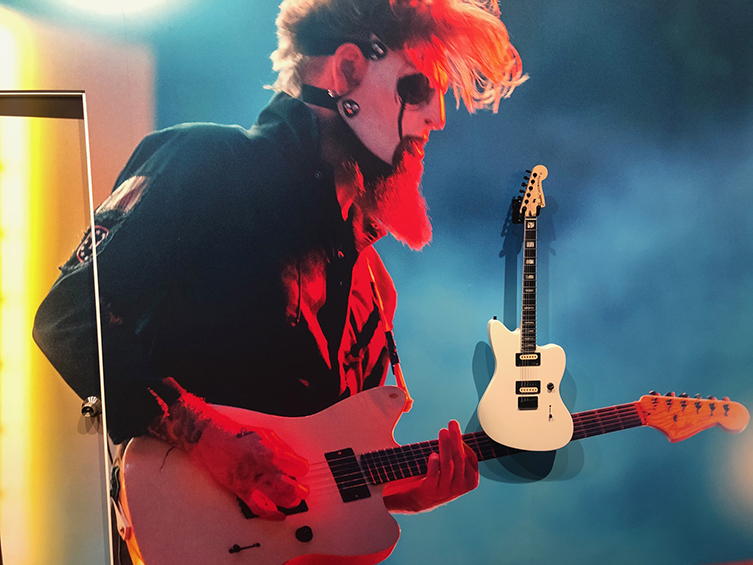
GG: Mm.
JR: So, it’s basically like a passive pickup in theory. It’s an active pickup in that is has an active preamp but the pickup itself is basically passive. You can still plug it into a preamp and all that, you can use different preamps with ‘em. We started with what I was comfortable with: the 81 and the 60, but we’re a few miles down the road from what those pickups are.
GG: Ok.
JR: They took a while for me to get used to. I wanted to go...one of the things I think the 81 and the 60 lack is...they have tons of gain, tons of compression and all that, but they lack a little bit of, like, that...it’s hard to say. Like, vibe, of feel? You know what I mean? Like, if you roll back the volume and you want to get a little more Bluesy, it’s a little bit harder to do that with the 81 and the 60 because they are so compressed.
GG: Yeah, I understand completely.
JR: So, I wanted to still be able to cut through, and have all the drive and all the stuff I need, but these have a lesser gain structure than, say, the 81 and the 60. Cuz I’m pushing the preamps on my amps so hard anyway...
GG: I was gonna say, with the gain available on amps...presumably you’re still using the Orange Rockerverbs?
JR: Um, I’m using a Rockerverb, but I’ve been using a Friedman.
GG: Oh wow! Well, you’ll be getting all the gain you ever need outta those.
JR: And then some! (laughs) So yeah, for the past...let’s see...shit, pretty much this whole album cycle, with the exception of maybe one month, I’ve been using the new BE-100 Deluxe.
GG: The Friedman stuff is unreal.
JR: Yeah man, that’s been my main guitar amp for this tour. Orange has just made me a new OR-100 that’s got some different things, and I used it in rehearsal and in pre-production, but I’m kinda favouring the Friedman.
GG: You okay with me saying that?
JR: I don’t mind you saying that. I’m not sure what I’m gonna do. I still love the Orange cabinets over the Friedman cabinets. It’s not like I’m tone chasing or anything like that, you know? I don’t have a signature amp with Orange any more, but they’ve been great to me. Absolutely amazing help.
GG: Sure.
JR: Like, everyone there is super-cool, and they’ve done so much for me. I don’t necessarily want to leave Orange, but....
GG: Things are developing.
JR: Yeah, I’m not...I’m more like into wanting to go for guitar amp with tonal characteristics a bit more than just...and that’s not to say Orange doesn’t have great tone: it does! It’s undeniable, but there’s just something about the Friedmans. They have that kinda...you know, they’re kinda like what Marshall should be doing.
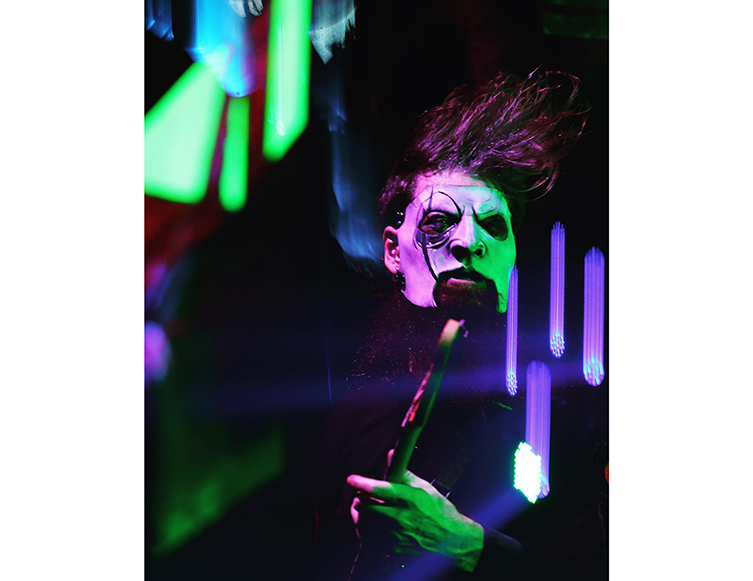
(Photo: Anthony Scanga)
GG: More Marshall than Marshall, like the Blade Runner chat: More Human than Human.
JR: Yeah! Haha! Instead of being a headphone company or whatever! Hahaha!
GG: Hahaha! Yeah! Yes! So, one thing I love asking guitar players: what kind of plectrum are you using? You have a signature one, right?
JR: Yeah, it’s a Tortex III shape, but it’s made out of the Jazz III material, the nylon.
GG: So it’s got a sharper tip?
JR: It’s a little bit sharper, yeah.
GG: Is it Jazz III thickness, then?
JR: It’s a little bit thicker than a Jazz III. I can’t remember the exact thickness, it’s like a 1.38 or something. It’s thicker than a 1mm, somewhere between a 1 and 1.5.
GG: Okay.
JR: But that’s only because of the moulding procedure. I found that the thicker the pick, the easier it glides over the strings, especially if you have more tension on the neck. If I’ve got a really slinky guitar, I tend to... I have .73mm Tortex III’s that I’ll grab. Sometimes those are better for solos. I’m kind of an inconsistent guitar player, haha!
GG: Haha, I know what you mean! But that leads to new things: sometimes a different plectrum changes everything about your playing.
JR: Yeah, kind of. And it’s all about the feel. And, you know, I’m a little bit neurotic as well, so if there’s something in my head, I’ll reach down and grab a different pick, it might not even be making any difference but in my head it is! (laughs) It’s like, I say to Brad, my new guitar tech:’ What should I find to bitch about now?’ Haha!
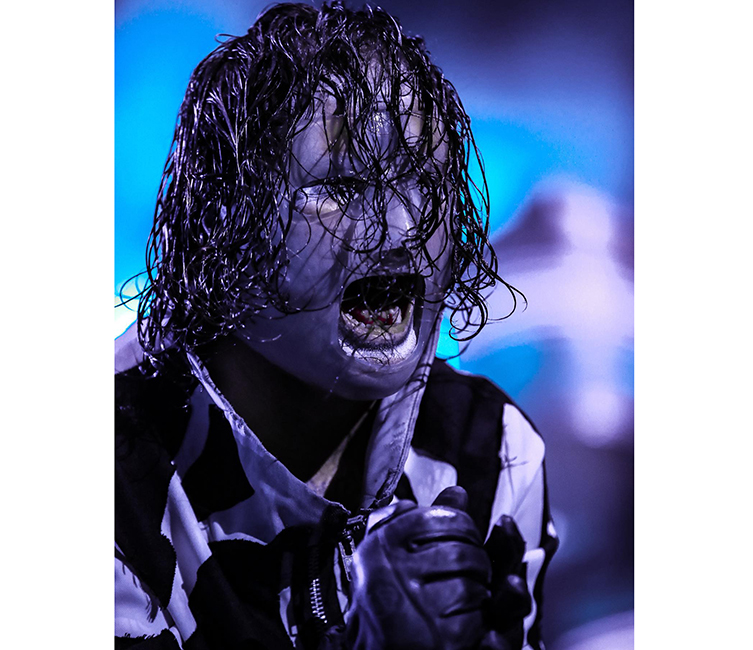
(Photo: Anthony Scanga)
GG: Hahaha! Now, I’m not 100% sure on the Slipknot songs, whether it’s your part or Mick’s (Thomson, Slipknot’s other guitarist) part, but I’ve always figured that all of the stranger, kind of more dissonant and textured bits might be your work?
JR: Yeah, I do a lot of the texturing.
GG: Away from the electronic stuff, of course.
JR: Yeah.
GG: The new record’s got some really cool stuff happening on it. Have you got any new pedals or toys you’ve been working with?
JR: Man, with all the plugins that everyone has, and all that stuff, there are so many different plugins. We’ll sit there in the studio and, like, go through the plugins but we’ll also have boxes and boxes of pedals on the floor, you know what I mean?
GG: Fun!
JR: There could be a chain of pedals, like I could have a little wah, and then I could be turning on all of these (mimes dialling things in on a huge pedalboard), blending like three filter pedals (laughs), fiddling with this and that, taking a wah and slowly moving it, you know? Or a Carbon Copy delay and getting it to do something really cool, record it, and then we’ll like, flip it and so on.
GG: And then you’ve got all the plugins afterwards!
JR: Yeah, and we can sample that part and Craig (Craig Jones, Slipknot’s keys and sample player) can recreate that part live.
GG: Oh, cool! So that happens as well?
JR: Yeah!
GG: That’s wicked!
JR: If Craig doesn’t come up with something on his own, like if he hasn’t written a part for a song, then we’ll give him all of the weird sounds that Mick or I can’t recreate, that we’ve done with pedals in the studio, and he can trigger all that stuff.
GG: Nice! That’s interesting.
JR: There’s loads of stuff like that.
GG: That’s so cool! One thing I did want to ask about was riffs. Obviously, Slipknot are a big riff band. Every record has moments that I would call ‘intensely satisfying mosh moments’...
JR: Haha, alright! Haha.
GG: Like on the new record, the one I really like is Nero Forte: it just slams.
JR: Yeah.
GG: So, when you’re at house, playing guitar, the first part is: do you stockpile riffs and record them on the computer to come back to later, and then the second part would be; do you think the best riffs happen what you don’t think about it? Like, when you try to write a great riff, it comes out shit, but when you just let yourself play, amazing things can happen?
JR: Haha, I think it’s both! I’ve got riffs that I’ve stockpiled for years and years and years. Sometimes you just get too involved with them in your head and don’t know where to take them, but you’ll listen to them six months to a year, or five years, later, it sounds totally different to you and you can make sense of it.
I’ve got other times where I’ve gone home and I’m feeling extremely, like, neurotic and I don’t have much going on, I make it a job to try go out and write every day in my garage or wherever. That’s cool too because when I do that, I’ve said this before, when we were doing the Grey Chapter (previous Slipknot album from 2014), I kinda channelled Paul (Gray, deceased Slipknot bassist) and the way Paul would write.
GG: Sure.
JR: And I learned a lot from him, just with trying different intervals, different chord shapes...for the same chord, y’know?
GG: Yeah, yeah!
JR: Chords that would sound better if I played it here or here (mimes different areas of a guitar neck) or taking riffs from other riffs, kinda like evolve a really complicated riff. Like, maybe this isn’t gonna translate? Maybe I can simplify this and take bits of the riff that are stand-out and just focus on those parts. Then that makes the melody. Cuz everything I do is based off 3 notes-per-string scales anyways, you know?
GG: Mm-hmm.
JR: So, most of my chording and riffs that I come up with are based on that kinda vibe and it’s like, for us, when we’re playing these arenas and stuff...if you’re playing really quiet and you’re a club band, and you’re really technical, all that stuff translates. But when you’re in a big echoey room with people who just want to jump, it’s hard to get that to translate. You know what I mean? Speed Metal and Death Metal and stuff like that, it’s not arena rock! (laughs)
GG: Yeah, simplifying sometimes makes a more effective point.
JR: Yeah, sometimes that definitely will help. But also, you want it to maintain its integrity from what it was.
GG: Yeah, stay true to the idea.
JR: So, it’s kinda a combination of a lot of different things. A lot of the more percussive things, like that riff (from Nero Forte): Clown wrote that from a drum cadence!
GG: Oh, nice!
JR: That’s also nice, because I don’t think of music percussively, or time-wise: I think of music melodically, you know what I mean?
GG: Yeah, got you.
JR: And Clown being a drummer, he’s more like, y’know, time signatures and different beats and things like that, whereas for me, it’s not about the right hand and doing these different things. It’s more about that (hums a descending note) liquid sort of movement that gives you that, you know? Sort of like, I dunno, Jonny from Radiohead kinda guitar playing, you know what I mean?
GG: I know exactly what you mean! He’s one of my favourite guys. Yeah, so one thing I wanted to ask was about Knotfest! It’s coming up soon!
JR: It is!
GG: First time we've had it in the UK! Excited?
JR: Thrilled! Hahahaha!
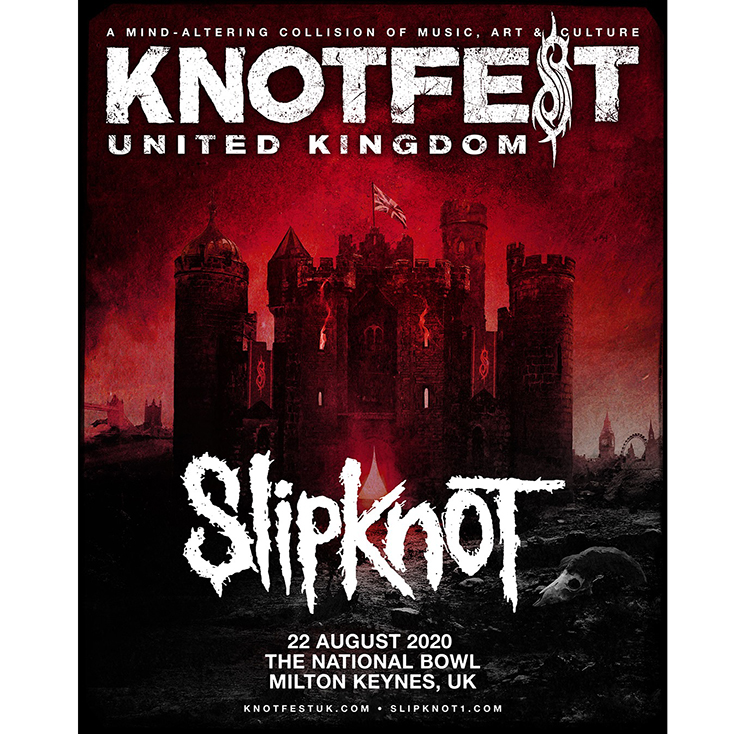
GG: Totally! What can fans expect from this Knotfest?
JR: Um, a bunch of memorabilia, and different circus-ey things, and the biggest thing for me with Knotfest is the museum.
GG: Sounds cool!
JR: We’ll have the whole museum with us. It’s pretty cool. I walked through it and there’s stuff there that I’ve forgotten about! Plaques and stuff like that, some of Paul’s outfits, masks and like, guitars in there that I haven’t played in fifteen years, that I haven’t even seen in fifteen years! Back from when I was endorsed by Jackson in the early 2000s, and Charvel: there’s my Charvel from the Before I Forget video. To me, that’s one of the coolest things.
By this point, Kristina had been standing in the room patiently for a few minutes, indicating the end of my conversation with Jim. We shook hands, Jim left, and Kristina led me back out, through the levels of security and back into the encroaching darkness of a Glasgow January.
My next task was to secure my interview slot with Behemoth, who were on their way back to the venue after a massively successful (over 300 people) signing at our Glasgow store.
But that’s another story!
Later that evening, both bands took to their stage in front of a packed audience of over 12000 metal fans. More details of Behemoth’s set will accompany their article.
Slipknot, though.
Wow.
Slipknot are one of the most thrilling live bands on the planet. They are unbelievably tight, even when it seems (by design) that everything is about to fall apart at any second! Do you like a proper show? Lights, pyro, flame-throwers coming from bass guitars? Moving floors? Twin percussionists hoisted 15 feet above the stage? This show has it all, with energy, passion and propulsion to spare. It’s a masterclass in performance. Slipknot tunes aren’t exactly easy to play, as we noted with Jim earlier, but these guys fling themselves around the stage with total abandon, whilst jets of pyro blaze away perilously close to the band members.
It’s exhilarating stuff. They make it look so easy! For fans, this is the event of the year, apart from perhaps Knotfest! It was a privilege to spend a little time in the company of Jim Root, and a rare look into the inner process of how this legendary player goes about constructing the songs we all love.
Slipknot are on tour just now with Behemoth. For details on this and the upcoming Knotfest, head over to the official Slipknot website.
We’d like to thank Jim for making time and space for us. We’d also like to thank Kristina and Michelle for all of their help before the event and on the day itself.
Read the accompanying Behemoth interview here!
Check out our selection of Fender Jim Root guitars here on the site.
Thanks for reading!


